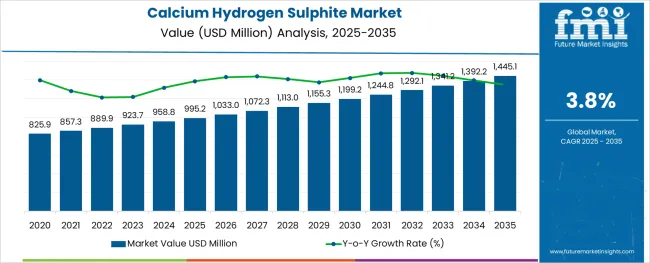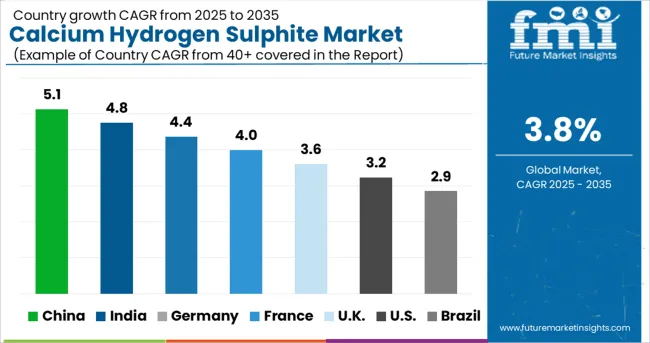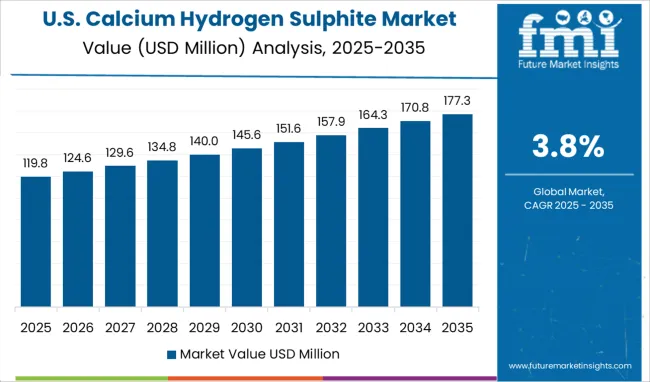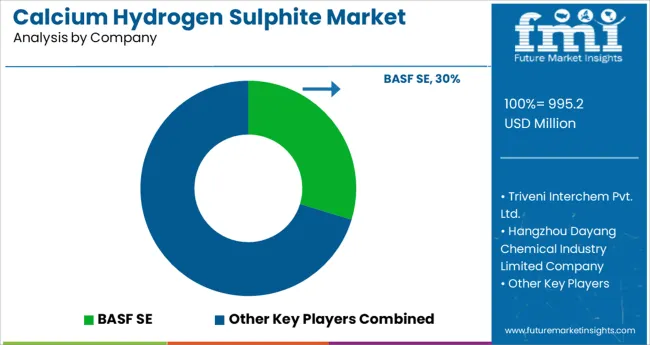The Calcium Hydrogen Sulphite Market is estimated to be valued at USD 995.2 million in 2025 and is projected to reach USD 1445.1 million by 2035, registering a compound annual growth rate (CAGR) of 3.8% over the forecast period.

The alginic acid market is undergoing consistent growth, propelled by rising demand from food processing, pharmaceutical formulations, and cosmetic applications. A growing focus on natural and sustainable ingredients in manufacturing processes has positioned alginic acid as a preferred biopolymer across industries.
The market is further supported by its diverse functional benefits, including water retention, gelling, and stabilizing properties, which make it indispensable in high-performance formulations. Increased regulatory acceptance of alginates as safe additives and the push towards cleaner labeling in food and personal care products have reinforced their adoption.
Ongoing innovation in extraction technologies and the utilization of algae as a renewable resource are paving the way for cost-effective production and expanded applications, ensuring sustained market expansion in the coming years.
The market is segmented by Grade and Application and region. By Grade, the market is divided into Technical Grade and Food Grade. In terms of Application, the market is classified into Food & Beverages, Paper & Pulp, Wastewater, and Others. Regionally, the market is classified into North America, Latin America, Western Europe, Eastern Europe, Balkan & Baltic Countries, Russia & Belarus, Central Asia, East Asia, South Asia & Pacific, and the Middle East & Africa.
When segmented by salts, sodium alginate is expected to command 27.5% of the market revenue in 2025, marking it as the leading subsegment in this category. This leadership has been driven by its superior solubility, ease of incorporation into formulations, and versatility in a wide range of applications.
Its ability to form stable gels and maintain viscosity under varying conditions has made it highly sought after in both food and pharmaceutical sectors. Manufacturers have prioritized sodium alginate due to its consistent performance, cost-effectiveness, and regulatory acceptance, which have collectively strengthened its position.
The segment’s prominence has also been enhanced by its adaptability to evolving consumer preferences for plant-derived and sustainable ingredients, reinforcing its market share.
Segmented by end user industry, the food industry is projected to hold 33.0% of the market revenue in 2025, positioning it as the most prominent sector. This dominance has been shaped by the industry’s increasing reliance on alginic acid and its derivatives to deliver desirable textures, stabilize emulsions, and improve shelf life of processed foods.
As consumer demand for clean label and natural additives has intensified, the food sector has responded by integrating alginates into bakery, dairy, and confectionery products. Enhanced production efficiency and compliance with food safety standards have further encouraged widespread use.
The segment’s leadership has also been supported by product differentiation strategies where alginates contribute to premium quality and innovation, securing their role in modern food formulations.
Affordable pricing of calcium hydrogen sulphite drives the consumption from end-use markets
The key factors that drive the calcium hydrogen sulphite market are its low price and high demand from the end use industries. When compared to alternatives, calcium hydrogen sulphite is more affordable, which is increasing the global consumption from the market.
The global calcium hydrogen sulphite market is being driven by customers' growing demand for ready-to-eat food and producers' management of the crucial component affecting the shelf life of the food. Calcium hydrogen sulphite is recognized as safe by independent food authorities in several nations, which enables the producers of calcium hydrogen sulphite to seize possibilities and increase their production capacity.
Additionally, the market is being driven by calcium hydrogen sulphite's multi-functional properties, such as its ability to prevent oxidative rancidity and other oxidative reactions in foods like cereals, limit enzymatic browning reactions stabilizes colour, and effectively inactivate microbiological conditions.
Government regulations on usage of calcium hydrogen sulphite are likely to affect the market growth
Despite of these market drivers, the global calcium hydrogen sulphide market is subjected to some restraints that may have a negative impact on the market. For instance, several independent agencies have put restrictions on the usage of calcium hydrogen sulphite.
The use of calcium hydrogen sulphites in liquors makes it difficult to recover and restricts its usage in industrial applications. In view of this Australian and New Zealand governments have banned on the calcium hydrogen sulphite for usage in industrial as well as food applications. Regulations like this limits the calcium hydrogen sulphite market's growth and expansion.
The industrial grade calcium hydrogen sulphide is widely used for industrial applications. The textile, pulp & paper, and water treatment industries use industrial-grade calcium hydrogen sulphite. It neutralizes chlorine and is employed as a disinfectant in the water treatment process.
Similar to this, pulp and paper and the textile sectors each employ industrial-grade products as bleaching agents. In the pulp and paper production process, calcium hydrogen sulphite is introduced to the digester along with wood pulp dissolving cellulose, pulp components, including lignin, for later use in the creation of paper.
As the food and beverage industry grows, it is anticipated that food-grade calcium hydrogen sulphite will hold a significant portion of the market over the projection period. Food preservative demand is being driven by rising demand for ready-to-eat meals.
Calcium hydrogen sulphide, being a preferred choice for food preservatives, is used in large quantities for packaged food products. However, the food industry is a regulated one, and thus, the calcium hydrogen sulphide.
There are some usage restrictions for calcium hydrogen sulphide bounded by its maximum allowable limit in food materials. Each country has a different maximum allowed limit. Although, due to modernization in the food & beverage industry, the requirement for food preservatives is growing year by year; thereby driving the consumption of calcium hydrogen sulphide.

Asia Pacific is seeing a significant growth in the end-use industries of calcium hydrogen sulphide. Rising urbanization and industrial growth in the region has driven the demand for water treatment as well as food & beverage industry. This growth brings the increase in consumption of calcium hydrogen sulphide for their wide scope of applications.
Abundant availability of raw materials and economical production of calcium hydrogen sulphide is expected to boost the market in forecast period. Due to this, Asia Pacific is expected to experience faster CAGR growth than the rest of the world over the forecast period for the worldwide calcium hydrogen sulphite.

Europe and North America are predicted to come after Asia Pacific as a result of the strict rules governing the food business in these two regions. The food and beverage sector in Europe is fiercely competitive and prioritizes products that are of the highest quality, are safe, and are governed by strict laws.
In North America, there is a sizable, intricate, and highly regulated food sector. Due to this, the prime end-user calcium hydrogen sulphide are seen in the industrial applications of calcium hydrogen sulphide rather than food preservatives. The market for calcium hydrogen sulphide will prominently be driven by growth of the water treatment and paper & pulp industry in the region.

Prominent players operating in the Global Calcium Hydrogen Sulphite market include BASF SE, Triveni Interchem Pvt. Ltd., Hangzhou Dayang Chemical Industry Limited Company, Henan Coreychem co., LTD, Haihang Industry Co., Ltd., Angene International Limited, and others.
The market of calcium hydrogen sulphite is mature with key manufacturers and new entrants would have to seek for new applications and target to the emerging markets of the calcium hydrogen sulphite.
The market is currently in a state of stagnation, with no key activities such as expansions, acquisitions, or collaborations observed. The market has enormous potential that has yet to be realized. Furthermore, traces in the product's research and development have been discovered for the exploration of new application areas. The results, however, have yet to be discovered.
| Attribute | Details |
|---|---|
| Growth Rate | CAGR of 3.9% from 2025 to 2035 |
| Base Year for Estimation | 2024 |
| Historical Data | 2020 to 2024 |
| Forecast Period | 2025 to 2035 |
| Quantitative Units | Revenue in USD Million, Volume in Tons and CAGR from 2025 to 2035 |
| Report Coverage | Revenue Forecast, Volume Forecast, Company Ranking, Competitive Landscape, Growth Factors, Trends and Pricing Analysis |
| Segments Covered | Grade, Application, Region |
| Regions Covered | North America; Latin America; Europe; East Asia; South Asia & Pacific; Middle East and Africa |
| Key Countries Covered | USA, Canada, Mexico, Brazil, Germany, UK, France, Italy, Spain, Russia, China, Japan, India, ASEAN, GCC Countries, Australia, Turkey, South Africa |
| Key Companies Profiled | BASF SE; Triveni Interchem Pvt. Ltd.; Hangzhou Dayang Chemical Industry Limited Company; Henan Coreychem co., LTD; Haihang Industry Co., Ltd.; Angene International Limited; A & Z FOOD ADDITIVES CO. |
| Customization & Pricing | Available upon Request |
The global calcium hydrogen sulphite market is estimated to be valued at USD 995.2 million in 2025.
It is projected to reach USD 1,445.1 million by 2035.
The market is expected to grow at a 3.8% CAGR between 2025 and 2035.
The key product types are technical grade and food grade.
food & beverages segment is expected to dominate with a 48.5% industry share in 2025.






Our Research Products

The "Full Research Suite" delivers actionable market intel, deep dives on markets or technologies, so clients act faster, cut risk, and unlock growth.

The Leaderboard benchmarks and ranks top vendors, classifying them as Established Leaders, Leading Challengers, or Disruptors & Challengers.

Locates where complements amplify value and substitutes erode it, forecasting net impact by horizon

We deliver granular, decision-grade intel: market sizing, 5-year forecasts, pricing, adoption, usage, revenue, and operational KPIs—plus competitor tracking, regulation, and value chains—across 60 countries broadly.

Spot the shifts before they hit your P&L. We track inflection points, adoption curves, pricing moves, and ecosystem plays to show where demand is heading, why it is changing, and what to do next across high-growth markets and disruptive tech

Real-time reads of user behavior. We track shifting priorities, perceptions of today’s and next-gen services, and provider experience, then pace how fast tech moves from trial to adoption, blending buyer, consumer, and channel inputs with social signals (#WhySwitch, #UX).

Partner with our analyst team to build a custom report designed around your business priorities. From analysing market trends to assessing competitors or crafting bespoke datasets, we tailor insights to your needs.
Supplier Intelligence
Discovery & Profiling
Capacity & Footprint
Performance & Risk
Compliance & Governance
Commercial Readiness
Who Supplies Whom
Scorecards & Shortlists
Playbooks & Docs
Category Intelligence
Definition & Scope
Demand & Use Cases
Cost Drivers
Market Structure
Supply Chain Map
Trade & Policy
Operating Norms
Deliverables
Buyer Intelligence
Account Basics
Spend & Scope
Procurement Model
Vendor Requirements
Terms & Policies
Entry Strategy
Pain Points & Triggers
Outputs
Pricing Analysis
Benchmarks
Trends
Should-Cost
Indexation
Landed Cost
Commercial Terms
Deliverables
Brand Analysis
Positioning & Value Prop
Share & Presence
Customer Evidence
Go-to-Market
Digital & Reputation
Compliance & Trust
KPIs & Gaps
Outputs
Full Research Suite comprises of:
Market outlook & trends analysis
Interviews & case studies
Strategic recommendations
Vendor profiles & capabilities analysis
5-year forecasts
8 regions and 60+ country-level data splits
Market segment data splits
12 months of continuous data updates
DELIVERED AS:
PDF EXCEL ONLINE
Potassium Hydrogen Sulphite Market
Calcium Dissolver Market Size and Share Forecast Outlook 2025 to 2035
Calcium Hypochlorite Market Size and Share Forecast Outlook 2025 to 2035
Hydrogen Storage Tank And Transportation Market Forecast Outlook 2025 to 2035
Hydrogen Detection Market Forecast Outlook 2025 to 2035
Calcium Silicate Insulation Market Size and Share Forecast Outlook 2025 to 2035
Calcium Carbonate Biocement Market Size and Share Forecast Outlook 2025 to 2035
Calcium Sulfate Market Size and Share Forecast Outlook 2025 to 2035
Hydrogenated Dimer Acid Market Size and Share Forecast Outlook 2025 to 2035
Calcium Chloride Market Size and Share Forecast Outlook 2025 to 2035
Hydrogen Electrolyzer Market Size and Share Forecast Outlook 2025 to 2035
Hydrogen Fluoride Gas Detection Market Size and Share Forecast Outlook 2025 to 2035
Hydrogen Storage Tanks and Transportation Market Size and Share Forecast Outlook 2025 to 2035
Calcium Gluconate in Pharmaceuticals Analysis - Size Share and Forecast outlook 2025 to 2035
Calcium Gluconate Demand Analysis - Size Share and Forecast Outlook 2025 to 2035
Hydrogen Refueling Station Market Size and Share Forecast Outlook 2025 to 2035
Hydrogen Aircraft Market Size and Share Forecast Outlook 2025 to 2035
Hydrogen Peroxide Market Size and Share Forecast Outlook 2025 to 2035
Hydrogen Fuel Cell Vehicle Market Size and Share Forecast Outlook 2025 to 2035
Hydrogen Pipeline Market Size and Share Forecast Outlook 2025 to 2035

Thank you!
You will receive an email from our Business Development Manager. Please be sure to check your SPAM/JUNK folder too.
Chat With
MaRIA